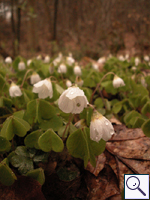|
||||||
| OXALIS.
Wood-sorrel. [Oxalidaceae]
|
|
Nineteen species of Oxalis are recorded in Britain. These include only one native species, Wood-sorrel (O. acetosella). The BSBI provide a downloadable plant crib for Oxalis. Two British miners are recorded on Oxalis. The polyphagous agromyzid Liriomyza huidobrensis has been recorded in quarantine in Britain. See also Liriomyza species in Glasshouses and/or Quarantine Interceptions. A key to the European miners recorded on Oxalis is provided in Bladmineerders van Europa.
|
 Wood-sorrel Oxalis acetosella |
Key for the identification of the known mines of British |
1a > Leaf mine: Corridor, widening into a full depth blotch. At the start of the corridor a lower-surface elliptic egg shell. The larva is capable of leaving its mine and making a new blotch mine elsewhere. Frass in the corridor in a central line, in the blotch as scattered grains. Pupation outside the mine. |
|
Pegomya seitenstettensis (Strobl, 1880) [Diptera: Anthomyiidae]. |
1b > Leaf-miner: A short, irregular, linear upper surface mine on any part of the leaf. Also recorded from young pods (Bland, 1997a). Long corridor mine. As a rule the first part of the mine is lower-surface, the later part upper-surface. Often the loops are so dense that a secondary blotch is the result. Because upper- and lower-surface corridor segments often cross, the mine obtains a strange array of transparant patches. There is no association with the midrib. Frass in strings and thread fragments. Pupation outside the mine; exit slit in upper epidermis. Mine not associated with the veins or midrib of the leaf (It is this character which enables distinction from another Agromyzid pest species - Liriomyza huidobriensis). The larvae may leave one leaf (if not large enough) and enter another leaf, via the petiole). It exits the leaf to pupate through a semi-circular slit in the upper surface of the leaf. |
|
Liriomyza bryoniae (Kaltenbach, 1858) [Diptera: Agromyzidae]. |
| Last updated 06-Jul-2019 Brian Pitkin | ||
